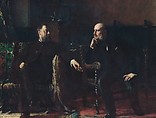The Funding Bill
Eastman Johnson American
Johnson established his reputation in the United States as a leading painter skilled at combining portraiture and genre, or figure, subjects. In this work, staged in Johnson’s New York parlor, Robert W. Rutherford, a relative of the painter by marriage, is depicted, at left, in conversation about a contemporary fiscal issue with Samuel W. Rowse, an artist-friend. Period critics praised Johnson’s fresh and animated treatment of the two men, especially in passages like Rowse’s slight turn and lean of his body indicating attentiveness, and Rutherford’s thoughtful expression and gesture. The 1881 funding bill, proposed by Congress to help restructure the national debt, caused alarm for bankers and businessmen who only recently had emerged from the economic depression of the 1870s. While the bill was ultimately vetoed by President Rutherford B. Hayes, Johnson’s painting presents the political debate as a civil intellectual discussion between his upper-class male peers.
Due to rights restrictions, this image cannot be enlarged, viewed at full screen, or downloaded.
This artwork is meant to be viewed from right to left. Scroll left to view more.



